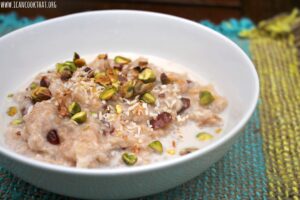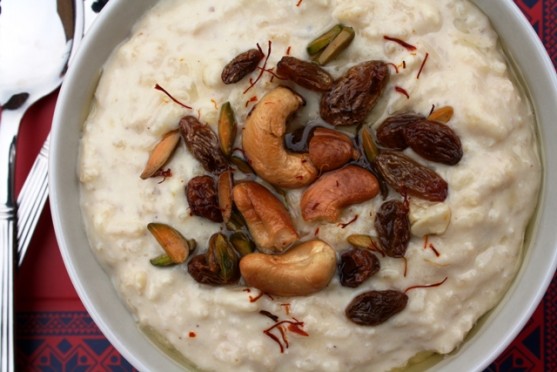Rice pudding with coconut milk introduction
Rice pudding with coconut milk offers a delightful twist on the classic dessert, infusing it with the rich, tropical flavor of coconut. This creamy and comforting treat brings together the familiar comfort of rice pudding with the exotic essence of coconut, resulting in a dessert that’s both familiar and unique.
With its creamy texture and subtle sweetness, coconut milk adds a luxurious depth to the rice pudding, elevating it to a whole new level of indulgence. Whether served warm or chilled, this coconut-infused dessert is sure to delight your taste buds and transport you to a tropical paradise with every spoonful.
In this recipe, we’ll explore how to create a luscious rice pudding using coconut milk, along with some optional toppings to customize it to your liking. Get ready to embark on a culinary journey that combines the best of comfort food with the exotic flavors of the tropics.
Rice pudding with coconut milk instruction
To make rice pudding with coconut milk, follow these simple instructions:
Ingredients:
1 cup of white rice (short-grain or jasmine)
1 can (13.5 oz) of coconut milk (full-fat for creaminess)
2 cups of water
1/4 teaspoon of salt
1/3 cup of sugar (adjust to taste)
1 teaspoon of vanilla extract
Optional toppings: shredded coconut, toasted nuts, cinnamon, or fresh fruit
Instructions:
Rinse the Rice: Start by rinsing the rice under cold water until the water runs clear. This helps remove excess starch and prevents the rice from becoming too sticky.
Combine Ingredients: In a saucepan, combine the rinsed rice, coconut milk, water, and salt. Stir well to combine.
Cook the Rice: Place the saucepan over medium-high heat and bring the mixture to a boil. Once boiling, reduce the heat to low and let the rice simmer, stirring occasionally to prevent sticking, for about 20-25 minutes or until the rice is tender and the mixture has thickened.
Sweeten and Flavor: Stir in the sugar and vanilla extract until they are well incorporated into the rice pudding mixture. Taste and adjust the sweetness if needed.
Serve: Once the rice pudding has reached your desired consistency and sweetness, remove it from the heat. You can serve it warm or chilled, depending on your preference.
Add Toppings: Garnish the rice pudding with your favorite toppings, such as shredded coconut, toasted nuts, cinnamon, or fresh fruit. These toppings add texture and flavor to the dessert.
Enjoy: Serve the coconut milk rice pudding in bowls and enjoy this creamy and flavorful dessert with friends and family.
Tips:
If you prefer a thicker consistency, you can simmer the rice pudding for longer to reduce the liquid.
Feel free to customize the sweetness of the pudding by adjusting the amount of sugar according to your taste preferences.
Experiment with different toppings to add variety and enhance the flavor of the rice pudding.
Leftover rice pudding can be stored in the refrigerator for a few days and enjoyed cold or reheated.
With these instructions, you’ll be able to create a delicious rice pudding infused with the tropical goodness of coconut milk. Enjoy this creamy and comforting dessert as a delightful treat any time of the day!

Rice pudding with coconut milk pros & cons
Sure, here are some pros and cons of making rice pudding with coconut milk:
Pros:
Rich Flavor: Coconut milk adds a rich and creamy texture to the rice pudding, enhancing its flavor profile with a subtle hint of coconut.
Dairy-Free Option: Using coconut milk instead of dairy milk makes this dessert suitable for individuals who are lactose intolerant or have dairy allergies.
Versatility: Coconut milk rice pudding can be easily customized with various toppings such as shredded coconut, nuts, fruits, or spices, allowing for endless flavor combinations.
Nutritional Benefits: Coconut milk contains essential nutrients like vitamins C, E, B1, B3, B5, and B6, as well as minerals like iron, selenium, sodium, calcium, magnesium, and phosphorus.
Texture: Coconut milk lends a smooth and creamy texture to the rice pudding, making it more indulgent and satisfying.
Cons:
Calorie and Fat Content: Coconut milk is high in calories and saturated fats, which may not be suitable for those watching their calorie or fat intake.
Coconut Flavor: While the coconut flavor enhances the overall taste of the rice pudding, it may not be preferred by everyone, especially those who do not enjoy coconut.
Cost: Coconut milk can be more expensive than dairy milk, depending on the brand and quality, which may impact the rice pudding’s overall cost.
Allergies: Although coconut allergies are relatively rare, individuals should avoid coconut milk and opt for alternative dairy-free milk options.
Storage: Coconut milk rice pudding may not have the same shelf life as traditional rice pudding made with dairy milk, especially if it contains perishable toppings like fresh fruit.
Overall, rice pudding made with coconut milk offers a delicious and dairy-free alternative to traditional rice pudding. Still, it’s essential to consider the potential drawbacks, such as its calorie and fat content, coconut flavor, and cost.

[…] Hydration reviews […]